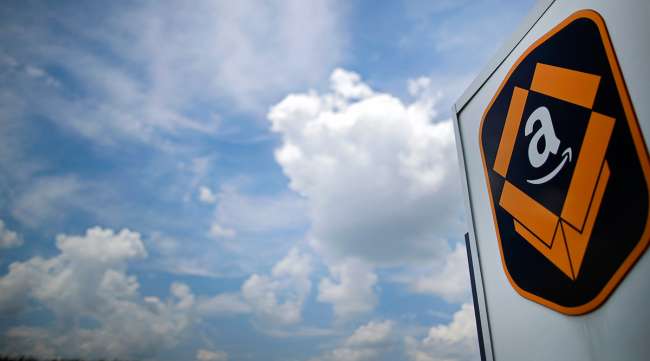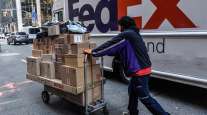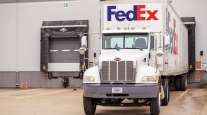Analysis: Amazon’s Delivery Dream Is a Nightmare for FedEx and UPS

Amazon’s ambition has been in plain sight for years. The company has built its own network of merchandise warehouses and package sorting centers. It enlisted its own airplanes and truck trailers to transport cargo. It registered to move freight across oceans, and in dozens of cities it tapped couriers to deliver packages directly to shoppers’ doors.
Brick by brick, Amazon has been building itself into a package delivery company to satisfy not only the voracious demands of Amazon shoppers but also anyone else who wanted to move merchandise from one place to another.
RELATED: Amazon's investment in warehouses, robots pays off in rising sales and bigger profit
RELATED: Amazon begins to act as its own freight broker
None of this has been a secret. Even a hush-hush company like Amazon.com Inc. can’t keep jet planes under wraps. But Amazon and its delivery partners such as FedEx have had plausible deniability about what’s been happening. When Amazon executives are asked whether they’re trying to become another FedEx or UPS, they say those Amazon trucks, warehouses, airplanes and delivery drivers are intended to supplement existing shipping providers when needed and improve service for Amazon shoppers.
This explanation wasn’t entirely believable, of course, and Amazon can no longer deny it. Amazon is coming for you, FedEx and UPS. Maybe not today or tomorrow. But soon.
UPS ranks No. 1 and FedEx No. 2 on the Transport Topics Top 100 list of the largest North American for-hire carriers.
Not ‘Fantastical’
The Wall Street Journal reported Feb. 9 that Amazon plans for the first time to pick up packages from businesses and ship them to customers. Initially, the Amazon delivery option will be only in Los Angeles and only for companies that sell merchandise through Amazon’s website. These are baby steps, but they are important symbolically.
It won’t stop with one city or one type of customer. Amazon can’t handle all deliveries on its own yet, but this is the company’s first direct move into FedEx and UPS territory.

FedEx CEO Fred Smith (Andrew Harrer/Bloomberg News)
Soon, those bold words from FedEx Corp.’s CEO will seem ridiculous. Two years ago, Fred Smith told stock analysts that concerns about Amazon shaking up the package shipping industry were “fueled by fantastical” reports. “In all likelihood, the primary deliverers of e-commerce shipments for the foreseeable future will be UPS, the U.S. Postal Service and FedEx,” Smith said.
Smith was factually correct and also blindingly wrong. It’s clear that Amazon’s delivery service won’t have the scope of UPS, FedEx or the Postal Service right away, and maybe not for years. Building a global shipping company is painstaking and expensive work. FedEx is 47 years old. Amazon has been earnest about building its own shipping infrastructure only since 2013, when the company’s delivery providers weren’t able to handle a surge of holiday season Amazon orders.
But is anyone willing to bet that it will take decades for Amazon to turn its patchwork of warehouses and intercity delivery operations into a full-fledged shipping network? Betting against Jeff Bezos is never wise, especially when his company has shown it is dead serious about honing its shipping skills.
Speedy Delivery
What does dead serious look like? Amazon in 2017 splurged $13.2 billion on warehouses and other logistics buildup for its operations in North America, according to securities filings that combine Amazon’s cash capital spending with its additions of physical real estate under leases and other financing arrangements. That was five times the comparable figure in 2015. For comparison, FedEx and UPS Inc. each had more than $5 billion in capital spending over the last year. This spending surge fits Amazon’s pattern: When it sees potential in a new area of business, it puts its foot on the gas pedal.
And Amazon executives have ever so slightly changed their message about their package delivery ambitions. Last week, Amazon’s chief financial officer gave the clearest (for Amazon) indication that his company plans to apply its delivery operations beyond Amazon’s own e-commerce deliveries: “Although we have a strong partner network here, we will always be able to leverage our strength and our knowledge about where shipments are going, both within our network and to final customers that will create opportunities for us.” The CFO didn’t detail what Amazon’s “opportunities” might be, but they are probably the stuff of Fred Smith’s nightmares.
T.S. Eliot wrote that the world ends “not with a bang but a whimper.” Business revolutions, though, begin not with a bang but with the first of hundreds of tiny steps. And when Amazon is involved, anyone standing in its way ends up whimpering.




